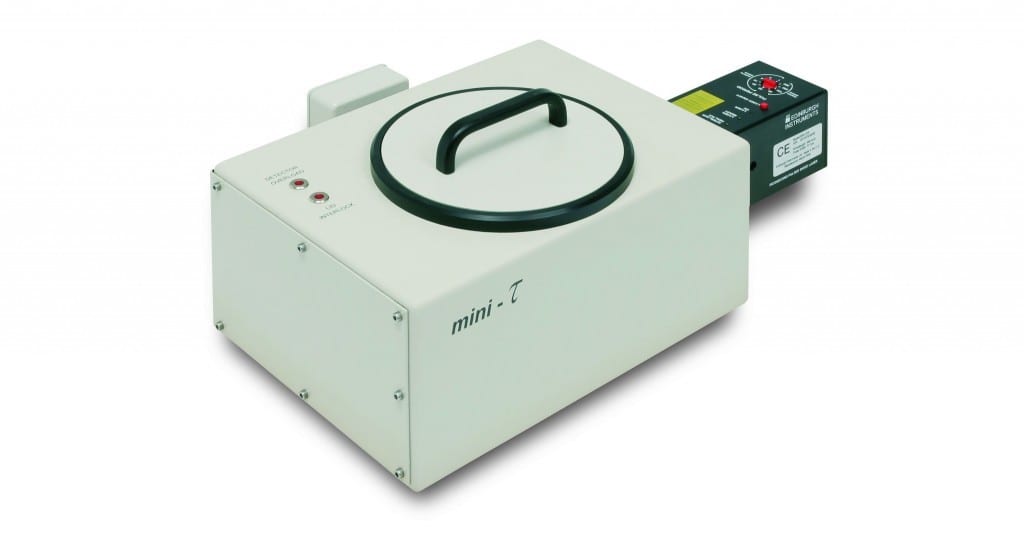
Mini-tau
- Ultra compact filter-based fluorescence lifetime spectrometer
- Short Lifetimes ranging from 25 ps to 10 μs
- MCS Option for lifetimes from 10 ns to 10 s
- Integrated electronics with repetition rates up to 100 MHz
- Ultra-fast blue or red sensitive single photon counting PMT for ultimate sensitivity
- Fully comprehensive data acquisition and analysis
Product Description
The Mini-tau is an ultra-compact, low cost, filter-based dedicated fluorescence lifetime spectrometer. Using the Time-Correlated Single Photon Counting (TCSPC) technique, the Mini-tau can measure fluorescence lifetimes ranging from 25 ps to 10 μs*. It can also be equipped with Multi-Channel Scaling (MCS) electronics for long-range photoluminescence from 10 ns to 10 s.
Whether you need to measure fluorescence lifetimes of time-resolved fluorescence anisotropy for research, quality assurance or teaching applications, the Mini-tau is the ideal all-inclusive, fully-integrated solution. The Mini-tau measures fluorescence lifetimes after numerical reconvolution based on the established Marquardt-Levenberg algorithm.
The Fluoracle Software supplied with the Mini-tau has an easy-to-use interface and allows users to comprehensively record data and accurately analyse complex decay kinetics of up to 4 lifetimes.
*Minimal lifetime resolution is laser dependent.
For more information, or to enquire, please contact a member of our sales team at sales@edinst.com.
Technical Specifications
| Specification | |
|---|---|
| Mode of operation | Time-Correlated Single Photon Counting (TCSPC), Multi-Channel Scaling (MCS) |
| Lifetime range | Approx. 25 ps – 10 µs (TCSPC), 10 ns – 10 s (MCS) |
| Instrumental pulse width | 250 ps (in standard configuration with diode laser excitation) |
| Excitation wavelengths | All picosecond pulsed diode lasers (EPL Series, HPL Series) and pulsed LEDs (EPLED Series) can be used in TCSPC (375 nm through to 980 nm). The above picosecond sources as well as variable pulse width sources (VPL Series, VPLED Series) can be used in MCS mode. |
| Attenuation | 4 orders of magnitude, linear |
| Filter Wheel | Comes as standard to accept 50 mm x 50 mm filters. Filter wheel with 5 bandpass filters of approx. 50nm width centred at 450nm, 500nm, 550nm, 600nm, and 650nm; one position without filter. |
| Detector | High speed PMT detector with amplifier, interlock and overload protection in fan-assisted TE cooled housing. Spectral range 230 nm – 850 nm or 230 nm – 920 nm, typical pulse width 180 ps, dark count rate 150 cps at 0°C. ps, dark count rate: 150 cps at 0°C |
| Data acquisition | TCC2 electronics module: up to 8192 channels per curve, forward or reverse mode, minimum channel resolution 305 fs, 20 ps time jitter, TAC ranges from 2.5 ns to 50 µs in TCSPC mode. Up to 8000 channels per curve, 10 ns resolution and up to 10 MHz repetition rate in MCS mode. |
| Data analysis | Marquardt-Levenberg algorithm – up to 4 lifetimes – anisotropy calculation |
| Dimensions | 265 mm (l) x 195 mm (d) x 125 mm (h) (excluding laser, detector, lid) |
| Weight | 5 kg (excluding laser, detector) |
Software
Fluoracle spectrometer operating software is at the heart of all our fluorescence spectrometers and is a fully comprehensive, user-friendly data analysis software package. Irrespective of system configurations, this software provides the user with complete control of the instrument and of most third-party accessories.
Fluoracle is Windows compatible and is based on a data centred design that enables the user to focus on their measurement. This guarantees ease-of-use in the operation of a modular and potentially complex spectrometer.
Measurement set-up and data acquisition is made through an intuitive menu system. Key spectroscopic parameters are easily accessed through functional groupings, while common measurement routines can be saved as method files to allow previous experiments to be easily repeated. Tabbed dialogue boxes and particular scan parameters are always visible during set-up. The current status of the instrument is also continuously displayed.
Fluoracle offers the FAST add on for the advanced analysis of fluorescence and phosphorescence decay kinetics.








